48 trends reshaping the film industry: Part 2 - Production
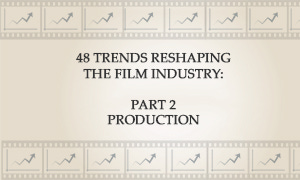
This is the second instalment of a four-part series chronicling 48 different trends and changes in the film industry.
Last week I gave you trends 1 to 12, in the fields of development and finance and in future weeks I will cover distribution, sales, exhibition and structural changes in how the film industry operates.
This week's twelve trends focus on the production sector, including details of changes to cast and crew.
13. Movie production worldwide is booming
In the ten years between 2000 and 2010, worldwide movie production doubled and has continued to rise since then. This boom is largely down to cheaper and easier to use technologies for shooting, finishing and distributing movies. In addition, the internet (especially YouTube) has democratised access to the knowledge needed to make and sell feature films.
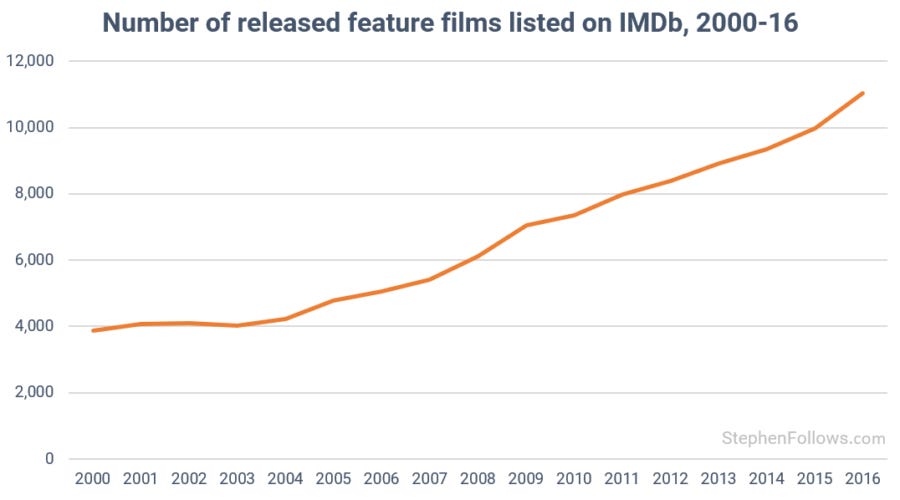
Countries with particularly fast growing production levels include South Korea, Italy, India and the US. Interestingly, the UK has seen falling levels of production - more on that topic later in this article.
Further reading: How many films are released each year? and How many films are made around the world?
14. Movies are predominantly shot digitally, but film remains in use
Hollywood started to capture films digitally in the 2000s but it wasn’t until 2013 that digitally shot films were more common than celluloid productions among the top 100 grossing films.
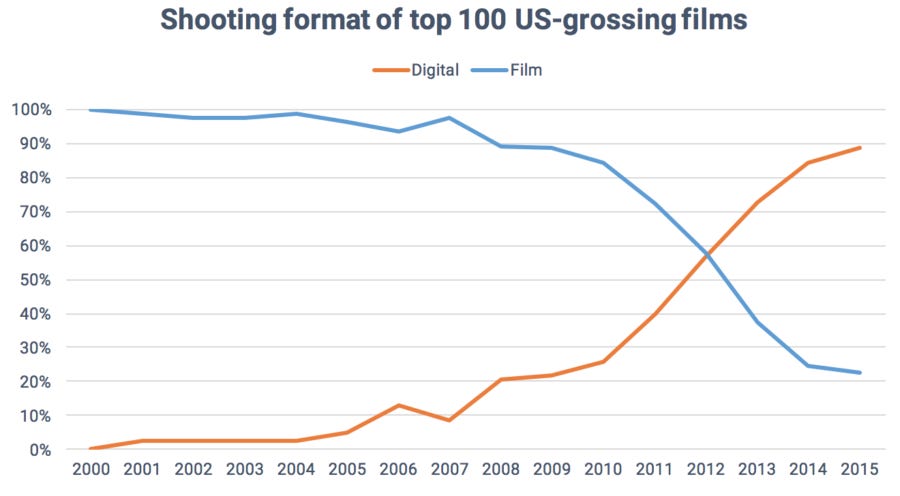
Further reading: Film vs digital – What is Hollywood shooting on? and When and how the film business went digital
15. Movies are getting longer
The average length of movies released in US cinemas has increased by almost three minutes over the last years.
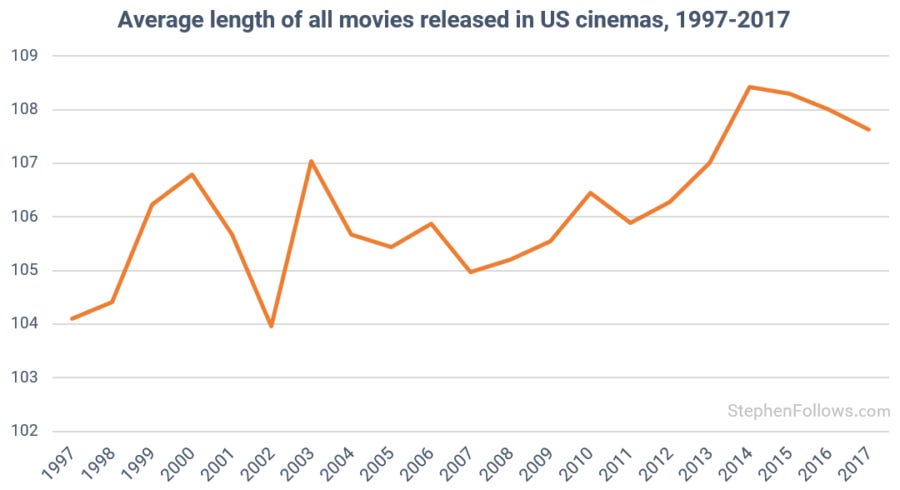
One of the longest films of recent times is Titanic. As the story goes, when James Cameron first told studio executives the final running time, they freaked out. They demanded cuts, to which Cameron responded in his world-renowned measured tone by saying “You want to cut my movie? You’re going to have to fire me! You want to fire me? You’re going to have to kill me!” They should count themselves lucky – he originally wrote it as a four hour epic.
Further reading: Are movies getting longer?
16. Crews on Hollywood movies are getting bigger
Twenty years ago, the average top grossing movie would credit 299 people in the cast and crew. In 2016 that swelled to 577 - almost double the 1997 figure.
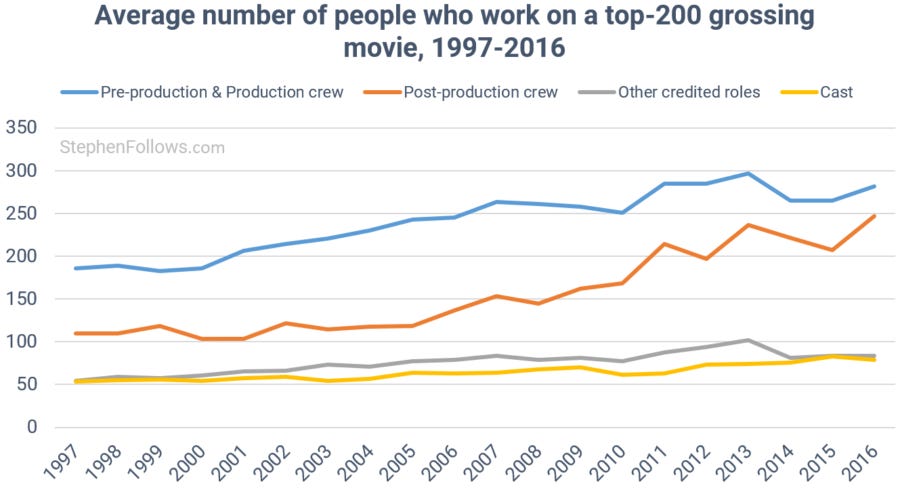
Further reading: How many stunt performers work on a movie?, How many Assistant Directors work on UK and US movies?, How many movies credits go uncredited?, How many people work on UK independent films?, How many people work on a Hollywood film? and How many people does it take to make a film in the UK?
17. Hollywood movies are getting wider
In the early days of film, movies were 1.33 : 1 (also called 4:3), which is close to being a square frame. However, when television came along and used the 4:3 format, Hollywood looked for new ways to make the cinema look bigger. They experimented with ever-wider formats, including ToddAO (2.20 : 1), CinemaScope (2.35 : 1), anamorphic (2.39 : 1 ) and Cinerama (2.59 : 1) to name just a few.
Most Hollywood movies decided on 1.85 : 1, which become the de facto standard from the mid 1950s up until around 2000. However, television started to copy the widescreen format, with 1.77 : 1 (also known as 16:9) becoming the norm for DVDs, Blu-ray and television broadcasts. From my research below, we can see that in response Hollywood has done what it did last time television stepped on its turf – it got wider.
Over two-thirds of the top US-grossing Hollywood films are now shot in 2.35 : 1, with under a third being released in 1.85 : 1.
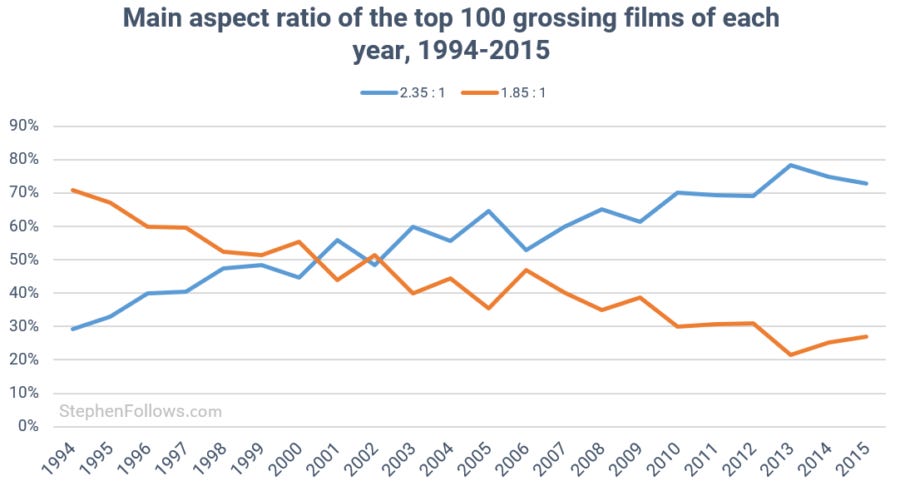
Further reading: Film vs digital – What is Hollywood shooting on? and 5 useless (yet interesting) film industry facts
18. The UK has overtaken Canada as Hollywood's favourite foreign location
In 2014, just under half of all Hollywood films were shot exclusively in the USA. A further 24% were filmed in a combination of the USA and other countries. Only 28% of films had their entire principal photography outside of the USA.
The UK and Canada have been competing to be Hollywood's favourite foreign shooting location. Thanks largely to its generous Film Tax Credit, the UK is pulling out in front.
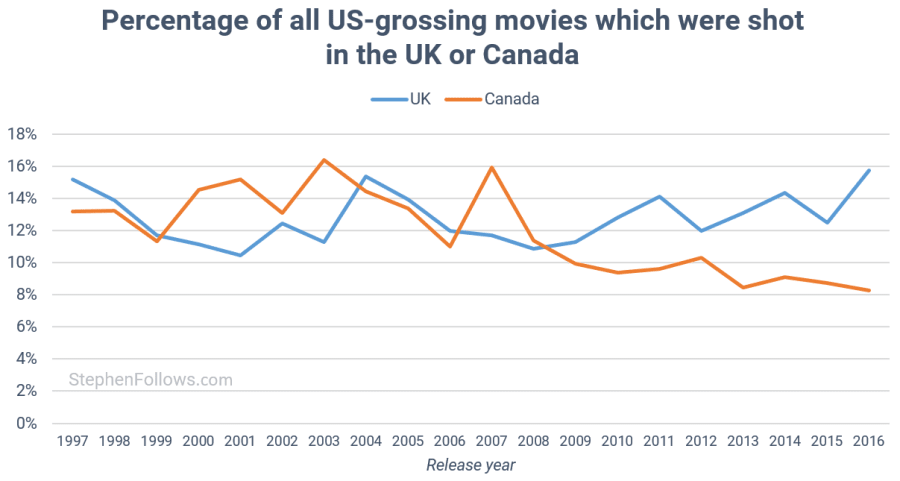
Further reading: Where are the top Hollywood movie locations? and How much of the UK film economy comes from abroad?
19. UK micro-budget production continues to nose-dive
In 2010, two-thirds of all films made in the UK were domestic productions costing less than £500,000. This was the high point of the short-lived British micro-budget boom and since then production levels have fallen in all but one year. This means that by 2016, they accounted for just a quarter of productions, and may continue to fall further in the years to come.
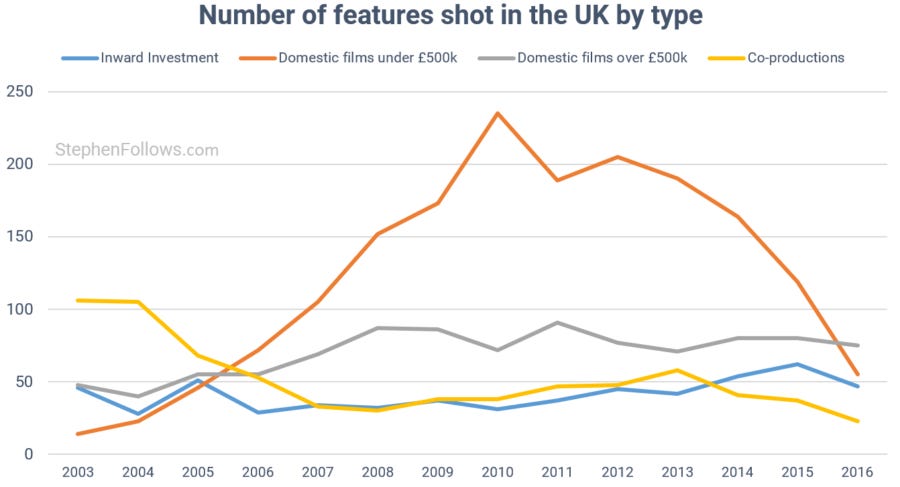
Further reading: What’s happened to UK low-budget film production? and Film industry responds to falling UK film production
20. Leading actors are getting older
The average age of lead actors was 39.9 years old in 2006 (this was their age on the movie's release date). Ten years later, this had grown to 45.0 years old, thanks mostly to a surge between 2011 and 2014.
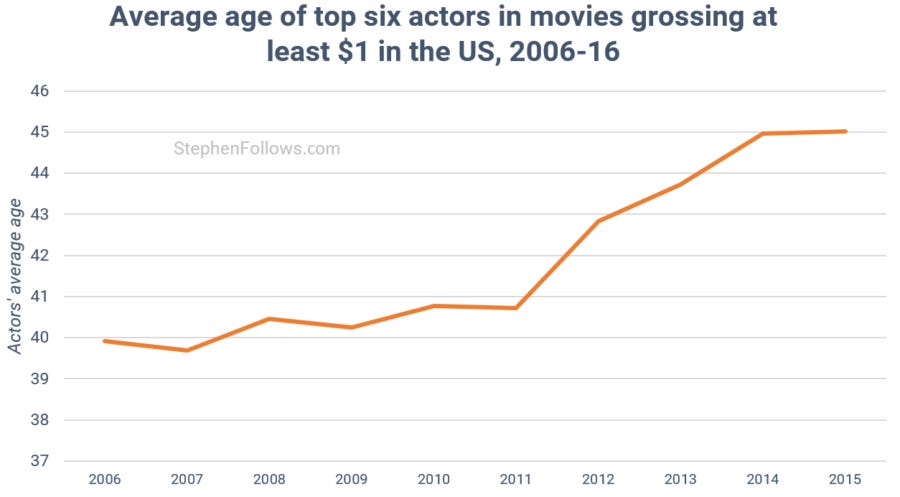
Musicals and Horror movies have the youngest average lead actors at just under 38 years old. Animations and Westerns have the oldest performers with an average age of 44.9 and 45.3 years, respectively.
Perhaps unsurprisingly, there is a big difference between the typical age of male and female actors. The average age of male lead actors was 42.8 years old, whereas the average age for female leads was 36.7, just over six years younger.
Further reading: Are heroes in action movies getting older? and How does the average age of actors differ between genres?
21. Producers, writers and directors are also getting older
The average age of a producer of a top 100 grossing movie in 1994 was 47. By 2014, the average age had increased by five years to 52. The average age of writers and directors also increased over the same period, by two and four years respectively.
Only 20% of Hollywood producers are under 40 years old, compared with 30% of directors and 42% of screenwriters.
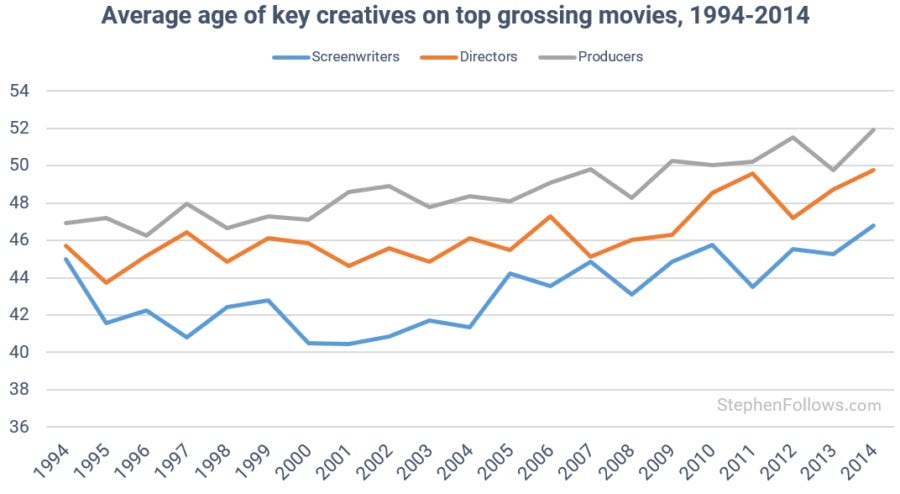
Over the studied period, the oldest living director of a top-grossing film was Clint Eastwood, who was 85 when American Sniper was released.
Further reading: How old are Hollywood directors?, How old are Hollywood screenwriters? and How old are Hollywood producers?
22. The number of post-production jobs has ballooned
Arguably, the employment sector which has seen the biggest technological changes over the past few decades is Post-Production. The processes involved in taking a film from the shoot to the final product has moved from being extremely physical (exposing film, cutting, splitting, etc) to almost entirely digital (digital footage, computer visual effects, digital deliverables, etc). There’s no doubt that digital technology has also affected the cameras used on set, but the rest of the technology has changed little (such as lenses and grip kit) and the workflow of how a film set runs is very similar.
This is reflected in the employment statistics, with post-production taking an ever-larger share of the film crew credits.
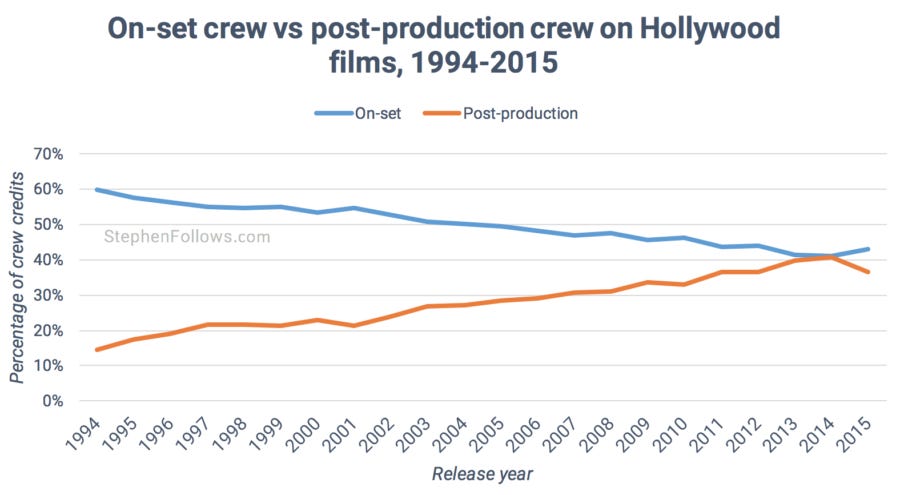
Further reading: Do more film crew members work on-set or in post-production?
23. The prevalence of writer-directors is increasing
In 2015 and 2016, over half of the top 100 grossing movies credited their director as a writer. This is a stark change from twenty years ago when it was around a quarter of movies.
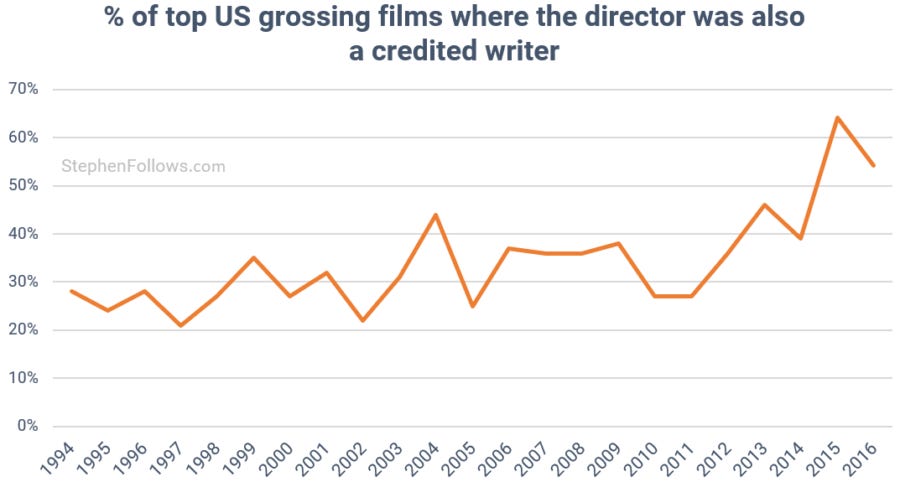
My research on the topic shows that writer-directors are more commonly found on lower budgeted films. The genres with the highest number of writer-directors are Sci-Fi, Mystery and Crime movies, with Adventure and Music-based films being the fewest.
Finally, you may be wondering if the presence of a writer-director improves the chance of a film being any good. The answer is... it's complicated. Writer-directors are much more common among films with the highest critics score (such as Christopher Nolan), but also among those with the lowest critics scores (such as Tyler Perry).
Further reading: What percentage of directors are writer-directors?
24. Little improvement in gender equality
These articles all focused on topics which show changes over time. However, I do want to include one trend which highlights something that's not really changing, namely gender equality. This is a topic close to my heart and one I have studied a number of times (links below).
95% of the directors of the top 200 grossing movies released in 1997 were men. Twenty years later, in 2016, the figure was again 95%. Year-on-year there are minor fluctuations but there is clearly no long-term trend towards improvement. That's not to say there hasn't been useful research, clever initiatives and some impressive people pushing the cause forward. But right now all we can say is that either the changes are yet to filter up to the major roles, or they have not been effective. Time will tell which it is.
To highlight where we are right now, below are the statistics on the gender of people taking major creative roles on all feature films released in US cinemas during 2017.
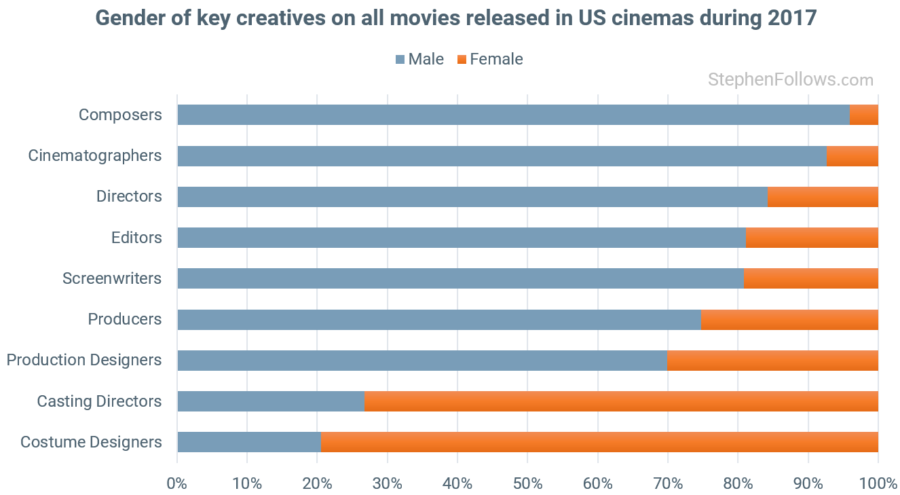
Further reading: A major new study into gender inequality in the UK film industry and What percentage of a film crew is female?
Notes
The data for today's article came from a variety of sources, including IMDb, Box Office Mojo, The Numbers, Wikipedia and the BFI . If you want to know more about a particular chart then I suggest following the 'Further Reading' link as it will provide more context and details of the data source(s).
Epilogue
In the coming weeks, I'll share more trends I've spotted in the film industry. If you think I've missed anything important then please do get in touch with me via my contact page or leave a comment below


